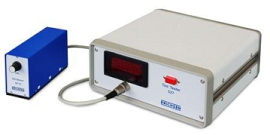
Simple and low cost test apparatus for continuous salt spray and condensation water testing. The test chamber with a volume of 400 l and all electric and pneumatic components to operate and control the test cycle are incorporated into a compact rectangular cabinet of plastic material. Complete, with specimen holders, storage tank for 90 l salt solution, pressure gauge and LCD for the temperature regulator and test time counter.

Compact Corrosion Testing Instrument For tests in accordance with all salt spray standards. The compact Corrosion Testing Instrument, Model 606-Basic, to perform salt spray and condensation tests, is made of impact resistant, eco-friendly polypropylene material and is delivered in a rectangular design in the following chamber volume capacities: 300 l, 400 l, and 1000 l (the new 300L size in a vertical orientation)

Compact instruments to determine the resistance to exposure to sun light using a Xenon high pressure lamp (1500 W or 2500 W). Adjustable levels of irradiance, uniform illumination by special mirror system, exchangeable filters for variable UV fraction. Programmable flooding system for periodic wetting of specimens available.

The HYGROTHERM 519 Smart model is equipped with a PLC control unit. The necessary test parameters are entered via a touch screen display with user-friendly menu navigation. Allows a fully automatic or manual process for testing the behavior of corrosion protection systems when exposed to condensation in accordance with DIN EN ISO 6270-2. Suitable for conducting condensed water constant (CH) and alternating climate (AHT, AT) tests and also for carrying out tests in an atmosphere containing sulfur dioxide according to DIN EN ISO 6988.

Inexpensive apparatus for testing the corrosion resistance of specimens in condensation water climate with or without SO2 addition in accordance with different standards. Robust 300 l plastic chamber with front door loading. A larger version with 1000 l test chamber volume can be supplied in special design.

The TINT TESTER 527, has been developed especially for brightness measurement of dark, uncured coatings such as paste pigment applications on flat surfaces, to determine the tinting strength according to ASTM D 3265 and ASTM D 2745. Besides this special application, the instrument can also be used as a standard reflection photometer to measure the brightness of solid substrates (coatings, paper, plastics, etc.) according to ASTM E 97.

Microprocessor controlled color comparison cabinet. Automatic operation based on manually preset program sequences. 3 types of illuminants: A, D65 and TL84. Facility for adding UV light to clarify response to the fluorescent effect. Control panel with foil pad keyboard and LCD. Display of operating hours and number of switching cycles for each light source. Accessories: Pivoting specimen table, light diffuser.

Damp photographic paper is pressed by a rubber pad under defined force onto the film surface in accordance with DIN 53 159. Evaluation of chalking mark by comparison with sample scale.

Operation via keyboard and display adjustable stroke rate and stroke path Parameter storage for 20 test cycles up to 3 tests simultaneously. For the assessment of the washing and scrubbing resistance as well as cleanability of dispersion paints (specifically ”wall paints”)., The wide range of its adjustable parameters allows also some further tailored/customized testing matters (for example for testing cleaning agents/solutions, etc.) as well. In the above standard applications a matt black PVC foil will be coated, and – if required – soiled in a defined manner. After clamping into the device it will be exposed under the influence of a washing liquid the stress of the moving scrub body.DIN 53 778-2 ASTM D 2486 DIN EN ISO 11998

The TABER® ABRASER 352 D (Platform), with its attractive and modern design, is a robust tabletop unit. The precise control and drive elements are located in a sturdy aluminum housing. Easy operation is via LCD touch screen, with functions such as abraser status, visual reference of completed test, cycle/time switching (completed or remaining), programmable pause interval, language selection and much more. The TABER® ABRASER Model 352 D (Type 1750) has two specimen holders for performing abrasion tests.
Purpose and application: Resistance to abrasion is one of the most important mechanical properties of surfaces. Among the methods used to test abrasion resistance, working with this unit is the most common and widely used method. Numerous national and international standards make explicit reference to this test instrument. The Original TABER® ABRASER can be used to perform abrasion tests on paintwork and other coatings, such as rubber, paper, leather, ceramics, textile fabrics and metals. This device is used in research and development as well as in production and quality control.
Principle of the test: The abrasion is caused by two friction rollers which act with a defined force on the rotating specimen holder to which the specimen is attached. An essential feature of these abrasion tests is the X-shaped grid. In acc. to EN 13329, NEMA LD 3-2000, EN 438-2, ISO 4586-2, NALFA LF-01









